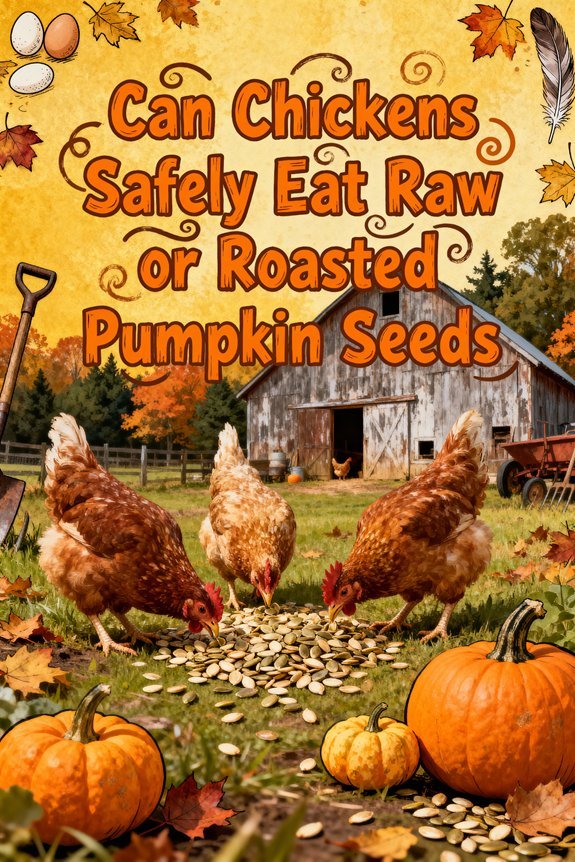Can Chickens Safely Eat Pineapple as a Treat?
You can safely feed pineapple to your chickens as an occasional treat, but proper preparation and portion control are vital. Cut ripe pineapple into 1/4-inch cubes, removing all skin, crown, and seeds. Limit servings to 1 tablespoon per adult chicken, offered 1-2 times weekly, representing no more than 10% of their daily diet. While pineapple provides valuable nutrients like vitamin C and bromelain, excessive consumption can lead to digestive issues. Understanding proper feeding guidelines guarantees your flock’s peak health.
The Safety Profile of Pineapple for Chickens
While pineapple offers nutritional benefits for chickens, its consumption requires careful monitoring due to several potential health risks. Your chickens can experience serious digestive issues if they consume excessive amounts, including sour crop from sugar fermentation and impacted crop from undigested skin. The bromelain enzyme presents additional concerns, potentially causing irritation to the mouth, esophagus, and digestive tract.
Pineapples provide minimal protein content that cannot meet a chicken’s dietary needs. A thorough nutritional analysis reveals that high sugar content can lead to metabolic complications, including hyperglycemia, obesity, and liver problems. Similar to cranberry sauce, excessive sugar in treats can cause blood sugar imbalances that compromise your flock’s health. You’ll need to limit portions to approximately one tablespoon per adult chicken, offered no more than twice weekly. It’s important to avoid feeding the peel or skin, which contain concentrated levels of irritating compounds and pose impaction risks. Like carrots, pineapple should be served as a supplement to a balanced diet rather than as a primary food source.
Essential Nutrients Found in Pineapple
Despite the potential risks of feeding pineapple to chickens, this tropical fruit contains a rich array of nutrients that can benefit poultry when administered appropriately. The nutrient composition includes essential vitamins like C, B6, thiamin, and folate, which support immune function and metabolic processes in chickens. You’ll find significant mineral content, particularly manganese at 67% of daily value per cup, along with copper and potassium that contribute to bone health and muscle function. Chickens can benefit from the polyphenols content (287.1mg) per serving, which provides natural antioxidant protection.
The vitamin benefits are complemented by bromelain, an enzyme that aids digestion, and various antioxidants that help combat oxidative stress. With approximately 82 calories per cup and 2.3 grams of fiber, pineapple provides a balanced combination of energy and digestive support when incorporated into your chickens’ treat rotation. Like almonds, pineapple is rich in protein and fiber that contribute to healthy growth and development in chickens. While treats like pineapple offer nutritional variety, remember that a quality layer feed should remain the foundation of your chickens’ diet to ensure they receive adequate protein, calcium, and essential nutrients for optimal health and egg production.
How to Properly Feed Pineapple to Your Flock
Four critical steps guarantee safe pineapple feeding to your chickens: proper preparation, portion control, careful monitoring, and hygienic handling.
When implementing feeding techniques, cut fresh pineapple into 1/4-inch cubes and serve on clean plates rather than directly on coop floors. Limit portions to 1 tablespoon per adult chicken, offering treats only 1-2 times weekly. Different pineapple types require specific preparation – remove tough outer skin, crown leaves, and seeds, while ensuring the fruit is perfectly ripe to prevent digestive issues. The fruit’s high content of bromelain enzyme can cause digestive irritation if overfed.
Monitor your flock during feeding sessions to prevent choking and remove uneaten pieces promptly. Maintain strict hygiene by washing preparation surfaces, tools, and feeding dishes. You’ll need to adjust serving frequency during laying periods to prevent nutrient imbalances from excessive sugar intake.
Best Serving Sizes and Feeding Schedule
Since proper portion control directly impacts flock health, understanding precise serving sizes and timing is essential for feeding pineapple treats to chickens. You’ll want to limit portions to approximately 2 tablespoons per bird for those consuming 0.25 pounds of daily feed. Offer pineapple treats once daily or several times weekly, but never exceed 5-10% of their total diet.
Establish a consistent feeding schedule by providing pineapple as an afternoon treat, avoiding times immediately before or after main meals. Remove any uneaten pieces within 15-20 minutes to prevent bacterial growth. When serving, cut the fruit into small, bite-sized chunks, removing the tough outer rind. Monitor your flock’s response and adjust serving sizes downward if you notice loose stools or decreased feed intake. The fiber content helps maintain proper digestion when served in appropriate amounts.
Health Benefits of Pineapple for Chickens
When incorporated into a balanced diet, pineapple offers chickens a rich array of essential vitamins, minerals, and bioactive compounds that support their overall health. You’ll find vitamin C, which strengthens the immune system and helps combat stress, while B-complex vitamins boost metabolism and energy production. The fruit’s bromelain enzyme enhances digestive health by breaking down proteins and reducing gut inflammation. Offering pineapple once or twice weekly helps maintain optimal nutritional balance.
Pineapple’s high water content aids hydration, while its potassium helps maintain electrolyte balance, particularly during hot weather. The fruit’s antioxidants protect cellular health and combat oxidative stress. For laying hens, the calcium and manganese content supports strong eggshells and bone health. The combination of vitamins A and C, along with iron and folic acid, promotes feather quality and helps prevent anemia. Popular breeds like Barred Plymouth Rocks, known for their steady egg-laying capability, can particularly benefit from these nutritional supplements to maintain their production of about 200 eggs per year.
Warning Signs of Overfeeding Pineapple
Monitoring your chickens for signs of pineapple overfeeding helps prevent serious health complications. Key overfeeding symptoms include lethargy, decreased activity levels, and noticeable weight gain. You’ll need to watch for changes in droppings consistency, particularly watery or loose stools, which indicate digestive issues from excess sugar and acid intake. Serving sugar-free dried pineapple can help prevent overconsumption while still providing treats.
Physical warning signs manifest as enlarged abdomens, reduced mobility, and potential skin irritation from bromelain exposure. Your chickens may exhibit altered behavior, such as dangerous pecking at thorny pineapple crowns. Footpad dermatitis can develop as obesity increases, compromising their health and comfort. Like with cheese treats, pineapple should be limited to about 10% of the diet to maintain optimal health and prevent digestive complications. If digestive issues persist or worsen, consider treating potential underlying conditions like coccidiosis infection with appropriate medication mixed in their drinking water. Regular observation of these indicators allows for timely adjustment of pineapple portions. If you notice these symptoms, immediately reduce or temporarily eliminate pineapple from their diet.
Preparing Pineapple for Your Chickens
After identifying overfeeding symptoms, proper pineapple preparation becomes your next focus for maintaining chicken health. When preparing fresh pineapple, cut it into 1/4-inch cubes to prevent choking hazards and guarantee easy consumption. You’ll need to wash the fruit thoroughly to remove potential pesticides, especially if you’re keeping the rind. Providing pineapple helps chickens get important B vitamins and minerals for optimal health.
Your cutting techniques should prioritize food safety and portion control. Serve the pineapple on elevated, clean surfaces, away from the coop floor to prevent contamination. You’ll want to remove uneaten pieces within 15-20 minutes to avoid pest attraction. Select ripe pineapples free of mold, and avoid those with fermentation odors or excessive softness. While you can include the rind and core, limit these fibrous parts and guarantee they’re clean before serving.
Balancing Pineapple With Regular Feed
To maintain ideal nutrition for your chickens, restrict pineapple treats to 10% of their total daily diet, equivalent to roughly 2 tablespoons for laying hens consuming 0.25 pounds of feed per day. The remaining 90% should consist of balanced commercial feed to guarantee adequate nutrient intake.
When implementing pineapple integration into your flock’s diet, you’ll need to monitor their response carefully. While pineapple provides beneficial vitamins C, B6, and A, along with minerals like manganese and potassium, it shouldn’t replace essential nutrients from regular feed. This dietary variety can support immune function and digestion through bromelain enzymes, but overfeeding may lead to digestive issues from excess sugars and acids. Make sure to remove any thorny crown portions before serving to prevent injury. Serve the fruit in small, manageable pieces, and always mix it gradually to allow your chickens to adapt without disrupting their primary nutritional intake. For additional immune system support, consider supplementing their diet with herbs like oregano and garlic, which offer antibiotic properties and parasite control.



